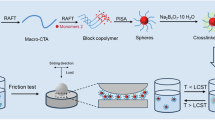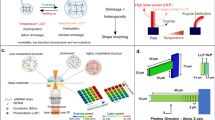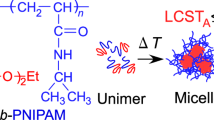Abstract
This paper describes the reversible phase transition behavior of a thermoresponsive poly(N-isopropylacrylamide) (PNIPAM) shell at the surface of a hydrophilic core. Reversible addition-fragmentation transfer (RAFT) polymerization of N-isopropylacrylamide was conducted using a hydrophilic hyperbranched poly(glycidol) (HPG)-based macroRAFT agent. At lower temperatures (<30 °C), the resultant multiarm star block copolymer (HPG–PNIPAM) exists as unimolecular micelles, with hydrophilic HPG as the core and a densely grafted PNIPAM brush as the shell. In laser light scattering (LLS) studies, the concentration used for HPG–PNIPAM is 5 × 10−6 g ml−1, to avoid any possible aggregation between dendritic unimolecular micelles above the lower critical solution temperature (∼32 °C) of PNIPAM. What we observe for the phase transition of HPG–PNIPAM involves only unimolecular process. A combination of dynamic and static LLS studies of HPG–PNIPAM in aqueous solution reveals a reversible phase transition on heating and cooling.
Similar content being viewed by others
Log in or create a free account to read this content
Gain free access to this article, as well as selected content from this journal and more on nature.com
or
References
Zhang, L. F. & Eisenberg, A. Multiple morphologies of crew-cut aggregates of polystyrene-b-poly(acrylic acid) block-copolymers. Science 268, 1728–1731 (1995).
Du, J. Z., Tang, Y. P., Lewis, A. L. & Armes, S. P. pH-sensitive vesicles based on a biocompatible zwitterionic diblock copolymer. J. Am. Chem. Soc. 127, 17982–17983 (2005).
Liu, S. Y., Billingham, N. C. & Armes, S. P. A schizophrenic water-soluble diblock copolymer. Angew. Chem., Int. Ed. 40, 2328–2331 (2001).
Liu, S. Y., Ma, Y. H. & Armes, S. P. Direct verification of the core-shell structure of shell cross-linked micelles in the solid state using X-ray photoelectron spectroscopy. Langmuir 18, 7780–7784 (2002).
Lee, A. S., Butun, V., Vamvakaki, M., Armes, S. P., Pople, J. A. & Gast, A. P. Structure of pH-dependent block copolymer micelles: charge and ionic strength dependence. Macromolecules 35, 8540–8551 (2002).
Zheng, G., Zheng, Q. & Pan, C. One-pot synthesis of micelles with a cross-linked poly(acrylic acid) core. Macromol. Chem. Phys. 207, 216–223 (2006).
Jiang, X. Z., Luo, S. Z., Armes, S. P., Shi, W. F. & Liu, S. Y. UV irradiation-induced shell cross-linked micelles with pH-responsive cores using ABC triblock copolymers. Macromolecules 39, 5987–5994 (2006).
O′Reilly, R. K., Joralemon, M. J., Wooley, K. L. & Hawker, C. J. Functionalization of micelles and shell cross-linked nanoparticles using click chemistry. Chem. Mater. 17, 5976–5988 (2005).
Thurmond, K. B., Kowalewski, T. & Wooley, K. L. Water-soluble knedel-like structures: the preparation of shell-cross-linked small particles. J. Am. Chem. Soc. 118, 7239–7240 (1996).
Tang, C. B., Qi, K., Wooley, K. L., Matyjaszewski, K. & Kowalewski, T. Well-defined carbon nanoparticles prepared from water-soluble shell cross-linked micelles that contain polyacrylonitrile cores. Angew. Chem., Int. Ed. 43, 2783–2787 (2004).
Joralemon, M. J., O′Reilly, R. K., Hawker, C. J. & Wooley, K. L. Shell Click-crosslinked (SCC) nanoparticles: a new methodology for synthesis and orthogonal functionalization. J. Am. Chem. Soc. 127, 16892–16899 (2005).
Satoh, T. Unimolecular micelles based on hyperbranched polycarbohydrate cores. Soft Matter 5, 1972–1982 (2009).
Njikang, G., Gauthier, M. & Li, J. M. Arborescent polystyrene-g-poly(2-vinylpyridine) copolymers as unimolecular micelles: solubilization studies. Polymer 49, 1276–1284 (2008).
Liu, H. J., Chen, Y., Zhu, D. D., Shen, Z. & Stiriba, S. E. Hyperbranched polyethylenimines as versatile precursors for the preparation of different type of unimolecular micelles. React. Funct. Polym. 67, 383–395 (2007).
Liu, H., Jiang, A., Guo, J. & Uhrich, K. E. Unimolecular micelles: Synthesis and characterization of amphiphilic polymer systems. J. Polym. Sci. Part A: Polym. Chem. 37, 703–711 (1999).
Thayumanavan, S., Bharathi, P., Sivanandan, K. & Vutukuri, D. R. Towards dendrimers as biomimetic macromolecules. C. R. Chim. 6, 767–778 (2003).
Najlah, M., Freeman, S., Attwood, D. & D′Emanuele, A. Synthesis, characterization and stability of dendrimer prodrugs. Int. J. Pharm. 308, 175–182 (2006).
Flory, P. J. dendrimer. J. Am. Chem. Soc. 74, 2718 (1952).
Hawker, C. J., Wooley, K. L. & Frechet, J. M. J. Unimolecular micelles and globular amphiphiles: dendritic macromolecules as novel recyclable solubilization agents. J. Chem. Soc. Perkin Trans. I 12, 1287–1297 (1993).
Uhrich, K. E., Hawker, C. J., Frechet, J. M. J. & Turner, S. R. One-pot synthesis of hyperbranched polyethers. Macromolecules 25, 4583–4587 (1992).
Carlmark, A., Hawker, C., Hult, A. & Malkoch, M. New methodologies in the construction of dendritic materials. Chem. Soc. Rev. 38, 352–362 (2009).
Hawker, C. J. & Frechet, J. M. J. Monodispersed dendritic polyesters with removable chain ends: a versatile approach to globular macromolecules with chemically reversible polarities. J. Chem. Soc. Perkin Trans. I 19, 2459–2469 (1992).
Nguyen, C., Hawker, C. J., Miller, R. D., Huang, E., Hedrick, J. L., Gauderon, R. & Hilborn, J. G. Hyperbranched polyesters as nanoporosity templating agents for organosilicates. Macromolecules 33, 4281–4284 (2000).
Hedrick, J. L., Trollsas, M., Hawker, C. J., Atthoff, B., Claesson, H., Heise, A., Miller, R. D., Mecerreyes, D., Jerome, R. & Dubois, P. Dendrimer-like star block and amphiphilic copolymers by combination of ring opening and atom transfer radical polymerization. Macromolecules 31, 8691–8705 (1998).
Frechet, J. M. J., Hawker, C. J. & Wooley, K. L. The convergent route to globular dendritic macromolecules: a versatile approach to precisely functionalized 3-dimensional polymers and novel block copolymers. J. Macromol. Sci. Part A A31, 1627–1645 (1994).
Wang, B. B., Zhang, X., Jia, X. R., Li, Z. C., Yan, J. & Wei, Y. Self-assembly of a new class of amphiphilic poly(amidoamine) dendrimers and their electrochemical properties. J. Polym. Sci. Part A:Polym. Chem. 43, 5512–5519 (2005).
Percec, V., Peterca, M., Dulcey, A. E., Imam, M. R., Hudson, S. D., Nummelin, S., Adelman, P. & Heiney, P. A. Hollow spherical supramolecular dendrimers. J. Am. Chem. Soc. 130, 13079–13094 (2008).
Schenning, A.P.H.J., Peeters, E. & Meijer, E. W. Energy transfer in supramolecular assemblies of oligo(p-phenylene vinylene)s terminated poly(propylene imine) dendrimers. J. Am. Chem. Soc. 122, 4489–4495 (2000).
Boas, U., Christensen, J. B. & Heegaard, P. M. H. Dendrimers: design, synthesis and chemical properties. J. Mater. Chem. 16, 3785–3798 (2006).
Gillies, E. R. & Frechet, J. M. J. Dendrimers and dendritic polymers in drug delivery. Drug Discov. Today 10, 35–43 (2005).
Cloninger, M. J. Biological applications of dendrimers. Curr. Opin. Chem. Biol. 6, 742–748 (2002).
Meyers, S. R., Juhn, F. S., Griset, A. P., Luman, N. R. & Grinstaff, M. W. Anionic amphiphilic dendrimers as antibacterial agents. J. Am. Chem. Soc. 130, 14444–14445 (2008).
Kim, Y. H. & Webster, O. W. Water-soluble hyperbranched polyphenylene: a unimolecular micelle. J. Am. Chem. Soc. 112, 4592–4593 (1990).
Yang, X., Sun, X., Chen, J., Liu, Y. & Wang, X. Study of hyperbranched poly(glycidol) sulfate electrolyte. J. Appl. Polym. Sci. 90, 1185–1190 (2003).
Žagar, E., Žigon, M. & Podzimek, S. Characterization of commercial aliphatic hyperbranched polyesters. Polymer 47, 166–175 (2006).
Garamus, V. M., Maksimova, T., Richtering, W., Aymonier, C., Thomann, R., Antonietti, L. & Mecking, S. Solution structure of metal particles prepared in unimolecular reactors of amphiphilic hyperbranched macromolecules. Macromolecules 37, 7893–7900 (2004).
Sunder, A., Kramer, M., Hanselmann, R., Mulhaupt, R. & Frey, H. Molecular nanocapsules based on amphiphilic hyperbranched polyglycerols. Angew. Chem., Int. Ed. 38, 3552–3555 (1999).
Kitajyo, Y., Imai, T., Sakai, Y., Tamaki, M., Tani, H., Takahashi, K., Narumi, A., Kaga, H., Kaneko, N., Satoh, T. & Kakuchi, T. Encapsulation-release property of amphiphilic hyperbranched D-glucan as a unimolecular reverse micelle. Polymer 48, 1237–1244 (2007).
Plate, N. A., Valuev, I. L. & Valuev, L. I. Water-soluble polymers with low critical solution temperature (LCST) as carriers for protein drug delivery. J. Biomater. Sci. Polym. Ed. 15, 415–422 (2004).
Galaev, I. Y. & Mattiasson, B. Thermoreactive water-soluble polymers, nonionic surfactants, and hydrogels as reagents in biotechnology. Enzyme Microb. Technol. 15, 354–366 (1993).
Wang, X. S., Lascelles, S. F., Jackson, R. A. & Armes, S. P. Facile synthesis of well-defined water-soluble polymers via atom transfer radical polymerization in aqueous media at ambient temperature. Chem. Commun. 1817–1818 (1999).
Schild, H. G. Poly(N-isopropylacrylamide)—experiment, theory and application. Prog. Polym. Sci. 17, 163–249 (1992).
Lang, Y. Y., Li, S. M., Pan, W. S. & Zheng, L. Y. Thermo- and pH-sensitive drug delivery from hydrogels constructed using block copolymers of poly(N-isopropylacrylamide) and Guar gum. J. Drug Delivery Sci. Technol. 16, 65–69 (2006).
Liu, S. Q., Tong, Y. W. & Yang, Y. Y. Thermally sensitive micelles self-assembled from poly(N-isopropylacrylamide-co-N,N-dimethylacrylamide)-b-poly(D,L-lactide-co-glycolide) for controlled delivers of paclitaxel. Mol. Biosyst. 1, 158–165 (2005).
Costa, R. O. R. & Freitas, R. F. S. Phase behavior of poly(N-isopropylacrylamide) in binary aqueous solutions. Polymer 43, 5879–5885 (2002).
Wu, C. & Zhou, S. Q. Laser-light scattering study of the phase-transition of poly(N-isopropylacrylamide) in water.1. Single-chain. Macromolecules 28, 8381–8387 (1995).
You, Y. Z., Hong, C. Y., Pan, C. Y. & Wang, P. H. Synthesis of a dendritic core-shell nanostructure with a temperature-sensitive shell. Adv. Mater. 16, 1953–1957 (2004).
Luo, S. Z., Xu, J., Zhu, Z. Y., Wu, C. & Liu, S. Y. Phase transition behavior of unimolecular micelles with thermoresponsive poly(N-isopropylacrylamide) coronas. J. Phys. Chem. B 110, 9132–9139 (2006).
Wang, X., Chen, J., Hong, L. & Tang, X. Synthesis and ionic conductivity of hyperbranched poly(glycidol). J. Polym. Sci. Part B: Polym. Phys. 39, 2225–2230 (2001).
Peng, Y., Liu, H. & Zhang, X. Star polystyrene-b-hyperbranched polyglycidol: synthesis and ionic conductivity. J. Polym. Sci. Part A: Polym. Chem. 47, 949–958 (2009).
Liu, C., Wang, G., Zhang, Y. & Huang, J. Preparation of star polymers of hyperbranched polyglycerol core with multiarms of PS-b-PtBA and PS-b-PAA. J. Appl. Polym. Sci. 108, 777–784 (2008).
Wei, X.- Z., Liu, X.- F., Zhu, B.- K. & Xu, Y.- Y. Membranes of crosslinked hyperbranch polymers and their pervaporation properties. Desalination 247, 647–656 (2009).
Zhou, L., Gao, C., Xu, W., Wang, X. & Xu, Y. Enhanced biocompatibility and biostability of CdTe quantum dots by facile surface-initiated dendritic polymerization. Biomacromolecules 10, 1865–1874 (2009).
Frey, H. & Haag, R. Dendritic polyglycerol: a new versatile biocompatible material. Rev. Mol. Biotechnol. 90, 257–267 (2002).
Burakowska, E. & Haag, R. Dendritic polyglycerol core-double-shell architectures: synthesis and transport properties. Macromolecules 42, 5545–5550 (2009).
Tamaki, M., Taguchi, T., Kitajyo, Y., Takahashi, K., Sakai, R., Kakuchi, T. & Satoh, T. LCST-type liquid-liquid and liquid-solid phase transition behaviors of hyperbranched polyglycerol bearing imidazolium salt. J. Polym. Sci. Part A: Polym. Chem. 47, 7032–7042 (2009).
Kainthan, R. K. & Brooks, D. E. Unimolecular micelles based on hydrophobically derivatized hyperbranched Polyglycerols: biodistribution studies. Bioconjugate Chem. 19, 2231–2238 (2008).
Kainthan, R. K., Mugabe, C., Burt, H. M. & Brooks, D. E. Unimolecular micelles based on hydrophobically derivatized hyperbranched Polyglycerols: ligand binding properties. Biomacromolecules 9, 886–895 (2008).
Kainthan, R. K., Janzen, J., Kizhakkedathu, J. N., Devine, D. V. & Brooks, D. E. Hydrophobically derivatized hyperbranched polyglycerol as a human serum albumin substitute. Biomaterials 29, 1693–1704 (2008).
Kumar, K. R. & Brooks, D. E. Comparison of hyperbranched and linear polyglycidol unimolecular reverse micelles as nanoreactors and nanocapsules. Macromol. Rapid Commun. 26, 155–159 (2005).
Michael Krämer, J.- F. S., Türk, H, Krause, S, Komp, A, Delineau, L, Prokhorova, S, Kautz, H & Haag, R pH-responsive molecular nanocarriers based on dendritic core-shell architectures. Angew. Chem., Int. Ed. 41, 4252–4256 (2002).
Kojima, C., Yoshimura, K., Harada, A., Sakanishi, Y. & Kono, K. Synthesis and characterization of hyperbranched poly(glycidol) modified with ph- and temperature-sensitive groups. Bioconjugate Chem. 20, 1054–1057 (2009).
Wilms, D., Stiriba, S.- E. & Frey, H. Hyperbranched polyglycerols: from the controlled synthesis of biocompatible polyether polyols to multipurpose applications. Acc. Chem. Res. 43, 129–141 (2010).
Xu, H., Luo, S. H., Shi, W. F. & Liu, S. Y. Two-stage collapse of unimolecular micelles with double thermoresponsive coronas. Langmuir 22, 989–997 (2006).
Wu, C. & Xia, K. Q. Incorporation of a differential refractometer into a laser light-scattering spectrometer. Rev. Sci. Instrum. 65, 587–590 (1994).
agar, E. & igon, M. Characterization of a commercial hyperbranched aliphatic polyester based on 2,2-bis(methylol)propionic acid. Macromolecules 35, 9913–9925 (2002).
Wu, C. & Zhou, S. Q. First observation of the molten globule state of a single homopolymer chain. Phys. Rev. Lett. 77, 3053–3055 (1996).
Zhang, G. Z. Study on conformation change of thermally sensitive linear grafted poly(N-isopropylacrylamide) chains by quartz crystal microbalance. Macromolecules 37, 6553–6557 (2004).
Liu, G. M., Cheng, H., Yan, L. F. & Zhang, G. Z. Study of the kinetics of the pancake-to-brush transition of poly(N-isopropylacrylamide) chains. J. Phys. Chem. B 109, 22603–22607 (2005).
Zhang, G. Z. & Wu, C. Quartz crystal microbalance studies on conformational change of polymer chains at interface. Macromol. Rapid Commun. 30, 328–335 (2009).
Yim, H., Kent, M. S., Satija, S., Mendez, S., Balamurugan, S. S., Balamurugan, S. & Lopez, G. P. Evidence for vertical phase separation in densely grafted, high-molecular-weight poly(N-isopropylacrylamide) brushes in water. Phys. Rev. E 72, 051801 (2005).
Balamurugan, S. S., Bantchev, G. B., Yang, Y. M. & McCarley, R. L. Highly water-soluble thermally responsive poly(thiophene)-based brushes. Angew. Chem., Int. Ed. 44, 4872–4876 (2005).
Yim, H., Kent, M. S., Satija, S., Mendez, S., Balamurugan, S. S., Balamurugan, S. & Lopez, C. P. Study of the conformational change of poly(N-isopropylacrylamide)-grafted chains in water with neutron reflection: molecular weight dependence at high grafting density. J. Polym. Sci. Part B: Polym. Phys. 42, 3302–3310 (2004).
Yim, H., Kent, M. S., Mendez, S., Balamurugan, S. S., Balamurugan, S., Lopez, G. P. & Satija, S. Temperature-dependent conformational change of PNIPAM grafted chains at high surface density in water. Macromolecules 37, 1994–1997 (2004).
Balamurugan, S., Mendez, S., Balamurugan, S. S., O′Brien, M. J. & Lopez, G. P. Thermal response of poly(N-isopropylacrylamide) brushes probed by surface plasmon resonance. Langmuir 19, 2545–2549 (2003).
Žagar, E. & Žigon, M. Molar mass distribution of a commercial aliphatic hyperbranched polyester based on 2,2-bis(methylol)propionic acid. J. Chromatogr. A 1034, 77–83 (2004).
Halperin, A., Tirrell, M. & Lodge, T. P. Tethered chains in polymer microstructures. Adv. Polym. Sci. 100, 31–71 (1992).
Teraoka, I. Polymer Solutions: An Introduction to Physical Properties (John Wiley & Sons, New York, 2002).
Acknowledgements
The financial support of the National Natural Scientific Foundation of China (20704001), the Anhui Provincial Natural Science Foundation (070414191) and the Project of Scientific Research for Young University Teachers of Anhui Province (2007jq1059) is gratefully acknowledged.
Author information
Authors and Affiliations
Corresponding author
Rights and permissions
About this article
Cite this article
Luo, S., Hu, X., Zhang, Y. et al. Synthesis of thermoresponsive unimolecular polymeric micelles with a hydrophilic hyperbranched poly(glycidol) core. Polym J 43, 41–50 (2011). https://doi.org/10.1038/pj.2010.93
Received:
Revised:
Accepted:
Published:
Issue date:
DOI: https://doi.org/10.1038/pj.2010.93
Keywords
This article is cited by
-
Castor oil-based waterborne hyperbranched polyurethane acrylate emulsion for UV-curable coatings with excellent chemical resistance and high hardness
Journal of Coatings Technology and Research (2019)



